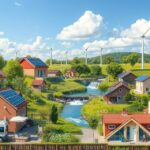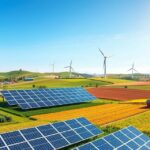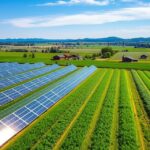Over 2.6 billion people cook using open fires or inefficient stoves. This causes major environmental and health issues. A DIY solar oven offers a smart solution to this problem.
Solar cooking uses sunlight to prepare meals without traditional energy sources. It helps people reduce their carbon footprint. You can enjoy tasty, sun-cooked meals while being eco-friendly.
Building a portable solar oven teaches you about renewable energy. It’s also a fun project for outdoor lovers and eco-warriors. You’ll learn new skills and help the environment.
This guide will show you how to make a DIY solar oven. You’ll learn the basics and cooking techniques. Get ready to discover how easy and effective solar cooking can be.

What is a DIY Solar Oven?
Solar cooking uses the sun’s energy to prepare meals. A homemade solar oven turns sunlight into a powerful cooking tool. This green project offers a new way to cook outdoors while helping the environment.
Understanding Solar Cooking
Solar cooking captures and focuses the sun’s energy to cook food. It uses reflective surfaces, dark containers, and insulated chambers to create high temperatures.
- Reflective surfaces direct sunlight toward a cooking area
- Dark-colored containers absorb and retain heat
- Insulated chambers maintain consistent temperatures
“Solar cooking is not just a method; it’s a sustainable lifestyle choice that connects us with nature’s energy.” – Environmental Cooking Research Institute
Benefits of DIY Solar Ovens
Homemade solar ovens offer unique advantages for eco-friendly cooks. These compact devices provide benefits that traditional cooking methods can’t match.
- Zero energy costs – Utilizing free solar energy
- Reduced carbon footprint
- Portable and lightweight design
- Safe for outdoor use
- Educational project for families
A DIY solar oven is perfect for campers, eco-warriors, and curious cooks. It’s an easy and fun green cooking project anyone can try.
Why Go Portable?
Portable solar cooking has changed outdoor meal prep. It offers a new way for adventurers to cook. Using solar energy turns outdoor meals into exciting food adventures.
Outdoor fans want flexible, eco-friendly cooking methods. Portable solar cookers fit the bill. They’re a green choice compared to regular camping stoves.
Convenience and Mobility
Solar cookers are incredibly portable. They offer many benefits for outdoor cooking.
- Lightweight design for easy transportation
- No fuel requirements
- Zero carbon emissions
- Compact storage capabilities
Fun Outdoor Cooking Experience
Portable solar cooking makes meal prep fun. You can cook lunch while hiking, camping, or at the beach. All you need is sunlight.
“Solar cooking isn’t just about food; it’s about creating memorable experiences in nature.” – Environmental Cooking Expert
| Activity | Solar Cooking Benefit |
|---|---|
| Camping | No fire risk, clean cooking method |
| Beach Trips | Effortless meal preparation |
| Hiking | Lightweight, energy-efficient cooking |
Try portable solar cooking for your next outdoor trip. It’s a fun, green way to make meals in nature.
Essential Materials for Your Solar Oven
A DIY solar oven is a fun, eco-friendly cooking project. It turns everyday items into a sunlight-powered cooking tool. Choosing the right materials is key to its success.
Building a solar oven needs careful planning and creativity. The right components will make your project shine.
Common Materials You Can Use
- Cardboard box (medium to large size)
- Aluminum foil or reflective metallic tape
- Black paint or black construction paper
- Clear plastic wrap or glass
- Scissors or utility knife
- Ruler and pencil
Eco-Friendly Alternatives
For eco-conscious builders, try these green options for your solar oven:
| Standard Material | Eco-Friendly Alternative |
|---|---|
| Cardboard Box | Recycled packaging or wooden crate |
| Aluminum Foil | Recycled reflective material |
| Plastic Wrap | Recycled glass or sustainable clear panels |
“Sustainability starts with choosing the right materials for your DIY solar oven.” – Green Living Experts
Your material choices affect your oven’s efficiency. Using sustainable items cuts waste and boosts your cooking experience.
Step-by-Step Guide to Building a Solar Oven
Building a solar oven is a fun, eco-friendly project. It’s easier than you might think. You’ll need simple materials and basic techniques.
Essential Tools for Your Project
Before you start, gather these key tools:
- Cardboard box
- Aluminum foil
- Black paint or black construction paper
- Clear plastic wrap
- Scissors
- Ruler
- Tape or glue
Detailed Assembly Instructions
Here’s how to build your solar oven:
- Select a sturdy cardboard box
- Line the interior with black paper for heat absorption
- Create reflective panels using aluminum foil
- Cover the top with clear plastic wrap
Safety Precautions
Keep these safety tips in mind:
- Work in a well-ventilated area
- Avoid sharp tool usage for children
- Use heat-resistant gloves
- Monitor temperature during cooking
“A homemade solar oven is not just a cooking tool, but a sustainable technology that connects us with renewable energy.” – Solar Cooking Enthusiast
Your solar oven will be a great addition to your outdoor cooking setup. It shows your creativity and care for the environment.
Types of DIY Solar Ovens
DIY solar ovens offer sustainable cooking options. Different designs have unique advantages for outdoor enthusiasts and eco-conscious cooks. Let’s explore various solar oven types to help you choose the best one.
Solar oven designs provide innovative home cooking solutions. Each type has distinct features and performance levels.
Box Solar Ovens: The Reliable Classic
Box solar ovens are the simplest design for beginners. These compact units are easy to make and use.
- Insulated rectangular shape
- Dark interior for heat absorption
- Transparent top lid for sunlight penetration
- Reflective panels to maximize heat collection
Parabolic Solar Ovens: High-Performance Cooking
Parabolic solar ovens use curved reflective surfaces for intense heat. They focus sunlight onto a specific cooking point. This design allows for faster cooking and higher temperatures.
“Parabolic solar ovens can reach temperatures up to 350°F, making them ideal for more complex cooking tasks.” – Solar Cooking Experts
Panel Solar Ovens: Lightweight and Portable
Panel solar ovens are perfect for outdoor cooking adventures. They’re made with reflective panels for easy transport. These designs are lightweight yet still generate heat efficiently.
Choose a solar oven based on your cooking needs and skill level. Try different styles to find the best DIY solar oven for you.
Tips for Effective Solar Cooking
Solar cooking is more than just building a solar cooker. It’s about understanding the nuances to create delicious meals. With the right knowledge, you can transform your outdoor cooking experience using sustainable energy.

Choosing the Right Location
Solar cooker instructions stress the importance of location. Choose an area with direct sunlight and minimal wind interference. Look for a spot with clear sky visibility and a flat, stable surface.
- Direct sunlight exposure
- Minimal wind interference
- Clear sky visibility
- Flat, stable surface
“The secret to successful solar cooking is patience and perfect positioning.” – Solar Cooking Expert
Timing Your Cooking Session
Portable solar cooking requires strategic timing. Peak cooking hours are typically between 10 AM and 2 PM. This is when sunlight is most intense.
Track solar angles and adjust your cooker to maximize heat absorption. This will help you get the best results from your solar cooking.
Best Foods for Solar Cooking
Some foods work better than others in solar ovens. Ideal candidates include rice, grains, stews, and casseroles. Slow-cooked meats and vegetables are also great options.
- Rice and grains
- Stews and casseroles
- Slow-cooked meats
- Vegetables
Pro tip: Dense, moisture-rich foods work best in solar cookers, as they retain heat effectively and cook evenly.
How to Optimize Cooking Temperature
The right temperature is vital for solar oven cooking success. Your solar oven’s effectiveness hinges on key factors that boost heat retention and cooking performance.
These factors can greatly improve your oven’s efficiency. Mastering them will enhance your outdoor cooking experience.
Solar ovens offer an eco-friendly way to cook. Learning to control your oven’s temperature can revolutionize your outdoor cooking.
Using Reflectors to Boost Heat
Reflectors are crucial in solar oven design. They concentrate sunlight and increase cooking temperature. Here are some effective reflector techniques:
- Positioning aluminum foil panels to redirect sunlight
- Using mirror-like surfaces for maximum light concentration
- Adjusting reflector angles throughout the day
Advanced Insulation Techniques
Good insulation keeps temperatures steady in your solar oven. Here are some insulation strategies to consider:
| Insulation Method | Effectiveness |
|---|---|
| Glass or Plexiglass Covers | Traps heat effectively |
| Foam Board Insulation | Provides excellent thermal barrier |
| Wool or Cotton Padding | Natural heat retention material |
“The secret to great solar cooking is understanding how to capture and maintain heat.” – Solar Cooking Expert
These techniques can help you create an efficient, eco-friendly solar oven. Try different reflector and insulation methods to find your perfect setup.
Experiment with various combinations. You’ll soon discover the ideal configuration for your solar cooking needs.
Maintenance and Care for Your Solar Oven
Proper care of your DIY solar oven ensures its longevity and performance. Regular maintenance guarantees safe and efficient cooking every time you use it.
Cleaning Your Solar Oven
Regular cleaning keeps your solar oven efficient. Here are simple steps to maintain your solar cooking equipment:
- Use warm, soapy water and a soft cloth to clean interior surfaces
- Avoid abrasive cleaners that might scratch reflective surfaces
- Dry thoroughly with a clean, soft cloth after washing
- Check seals and reflective materials for any signs of wear
“A well-maintained solar oven is the key to successful sustainable cooking” – Solar Cooking Enthusiasts
Storing Your Solar Oven
Proper storage protects your DIY solar oven from damage. It keeps it ready for your next outdoor cooking adventure.
Here are some helpful storage tips:
- Store in a cool, dry place away from direct sunlight
- Cover with a protective cloth or case
- Avoid storing in damp or humid environments
- Keep away from sharp objects that might damage reflective surfaces
Pro tip: Always inspect your solar oven before and after storage to catch any potential issues early.
Exploring Recipes for Solar Cooking
Solar cooking offers a fun way to make tasty meals outdoors. It’s great for nature lovers and eco-friendly cooks. This green method turns simple foods into yummy dishes using only the sun’s power.
Solar ovens create a special cooking experience. They use natural energy to make delicious meals. It’s an exciting way to cook while helping the environment.
Solar cooking needs some creativity. You must know how heat changes food. It may seem hard at first. But with practice, you’ll find many great dishes to make.
You’ll discover lots of tasty options for portable solar cooking. These work well with the sun’s energy.
Easy Recipes to Try
- Sun-Baked Vegetable Medley A simple mix of seasonal vegetables seasoned with herbs, perfect for beginners in solar cooking.
- Solar Rice Pudding A sweet treat that slowly cooks to creamy perfection using solar energy.
- Herb-Roasted Chicken A classic dish that becomes tender and flavorful when prepared in a solar oven.
Advanced Solar Cooking Ideas
Skilled solar cooks can try harder recipes. These dishes test the limits of green cooking. You can experiment with meals that need exact heat control.
| Recipe | Difficulty Level | Cooking Time |
|---|---|---|
| Solar Bread | Advanced | 2-3 hours |
| Slow-Cooked Solar Stew | Intermediate | 3-4 hours |
| Solar Baked Cheesecake | Expert | 2-2.5 hours |
“Solar cooking is not just a method of preparation, it’s a connection to nature and sustainable living.” – Solar Cooking Enthusiast
Patience is key in portable solar cooking. Each recipe needs careful placement and timing. Pay attention to get the most from the sun’s cooking power.
Real-Life Success Stories
Solar cooking is changing lives across the US through eco-friendly projects. These stories show how green cooking cuts carbon and helps families. It offers practical solutions for communities too.
Community projects showcase sustainable cooking innovation. In Arizona, a solar cooking project helps indigenous groups use less traditional fuel. This eco-friendly solution also creates jobs for locals.
The initiative has had a big impact. It cut energy use by 70% and slowed deforestation. It also improved air quality in community areas.
Community Impact Highlights
- Reduced energy consumption by up to 70%
- Decreased deforestation in remote regions
- Created sustainable job opportunities
- Improved air quality in community spaces
Individual Experiences
Personal stories show how solar ovens can change lives. Sarah Rodriguez, a California educator, shared her thoughts. “My solar oven has completely changed how I approach cooking. It’s not just about saving energy – it’s about connecting with a more mindful way of preparing food.”
“Solar cooking isn’t just a technique – it’s a lifestyle choice that impacts our planet positively.” – Environmental Sustainability Network
People find many benefits in eco-friendly cooking. Solar ovens work well for campers and backyard chefs. They blend sustainability with cooking creativity.
Innovative Applications
- Emergency preparedness cooking
- Outdoor recreational cooking
- Sustainable home cooking alternatives
- Educational demonstration projects
These success stories prove sustainable cooking is more than just an idea. It’s a real solution changing our views on energy and food prep. It also boosts environmental responsibility.
The Importance of Sustainable Cooking
Sustainable cooking is key to saving the environment and empowering people. The green cooking movement is changing how we make meals. It focuses on eco-friendly methods that cut carbon emissions and help local ecosystems.
People now see how cooking affects the environment. Solar cooking is a great solution in this project. It offers many benefits over traditional cooking methods.
Minimizing Carbon Footprint
Solar cooking greatly cuts carbon emissions by not using fossil fuels. It has many environmental benefits.
- Zero direct greenhouse gas emissions
- Reduced deforestation from wood fuel consumption
- Minimal energy infrastructure requirements
- Lower overall carbon footprint compared to traditional cooking methods
Supporting Local Agriculture
The green cooking project links to local farming sustainability. Solar cooking promotes fresh, local ingredients. This approach has several advantages.
- Shorter food transportation distances
- Support for regional farming communities
- Reduced packaging and processing waste
- Enhanced nutritional quality of meals
“Sustainable cooking is not just about the meal, but the entire ecosystem surrounding its preparation.” – Environmental Food Network
| Cooking Method | Carbon Emissions | Local Impact |
|---|---|---|
| Traditional Gas Stove | High | Minimal |
| Electric Stove | Medium | Moderate |
| Solar Oven | Zero | Significant |
By embracing sustainable cooking technologies, individuals can make meaningful contributions to environmental preservation while enjoying delicious, responsibly prepared meals.
Future of Solar Cooking
Solar cooking technology is evolving rapidly. Innovative designs are transforming eco-friendly cooking. Researchers are developing efficient DIY solar oven prototypes to revolutionize sustainable cooking methods.
Recent material science advancements have improved solar ovens. They’re now more compact, lightweight, and powerful. Companies like GoSun and SunFocus are creating solar cookers that reach higher temperatures faster.
These devices maintain consistent heat. This makes DIY solar ovens more practical for everyday use.
Innovations in Solar Oven Design
Modern solar ovens use advanced reflective materials and improved insulation. They also feature smart tracking systems that maximize sun exposure. MIT is researching cutting-edge solar cooking technologies.
These innovations could solve cooking challenges in remote or energy-limited regions.
Rising Popularity of Solar Cooking in the US
Sustainable cooking methods are gaining momentum in the United States. Outdoor enthusiasts and environmental advocates are embracing solar cooking. Home cooks also see it as a green alternative to traditional techniques.
This shift shows growing awareness about reducing carbon footprints. It also highlights interest in innovative, eco-friendly cooking solutions.
FAQ
What exactly is a solar oven?
A solar oven cooks food using sunlight. It captures solar energy with reflective surfaces, turning it into heat. This eco-friendly cooking method needs no electricity or gas.
How hot can a DIY solar oven get?
A well-designed solar oven can reach 200-350°F (93-176°C). The temperature depends on sunlight intensity, reflector design, and insulation quality.
What types of food work best in a solar oven?
Slow-cooking foods excel in solar ovens. Stews, rice, beans, casseroles, and baked goods are ideal. Foods needing gentle, consistent heat work best with solar cooking.
How long does it take to cook food in a solar oven?
Cooking times are like conventional ovens. Meals usually take 1-3 hours, depending on sunlight and recipe. Some dishes might need a bit longer than traditional methods.
Are solar ovens safe to use?
Yes, solar ovens are safe when used properly. They have no flames and produce no harmful emissions. Users should use heat-resistant gloves and protect their eyes from bright reflections.
Can I use a solar oven during cloudy weather?
Solar ovens work best in direct sunlight. They can generate some heat on cloudy days, but cooking takes longer. Clear, sunny days are ideal for solar cooking.
What materials do I need to build a basic solar oven?
Common materials include cardboard, aluminum foil, and black paint. Glass or plastic wrap and insulation like newspaper or foam are also used. Most projects use everyday household items.
How environmentally friendly are solar ovens?
Solar ovens are very eco-friendly. They produce no carbon emissions and use no fossil fuels. These ovens offer a sustainable cooking solution with minimal environmental impact.
Can solar ovens be used for camping or outdoor activities?
Yes! Portable solar ovens are great for outdoor adventures. They’re light, easy to carry, and perfect for camping, picnics, and beach trips. Solar ovens offer unique cooking in various settings.
How much does it cost to build a DIY solar oven?
DIY solar ovens usually cost $10-$50. The price depends on design complexity and materials used. Many basic models can be made with cheap or recycled items.






